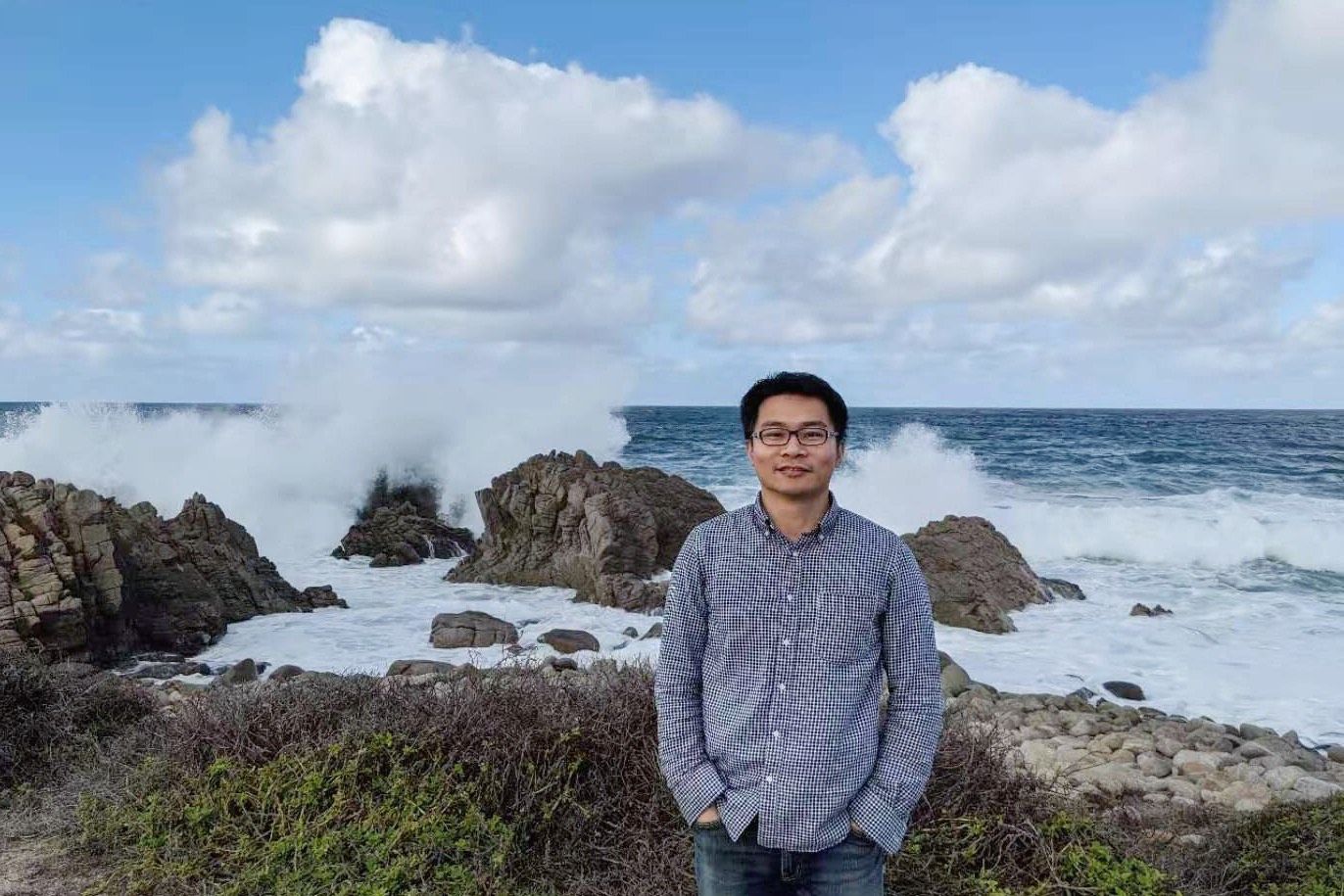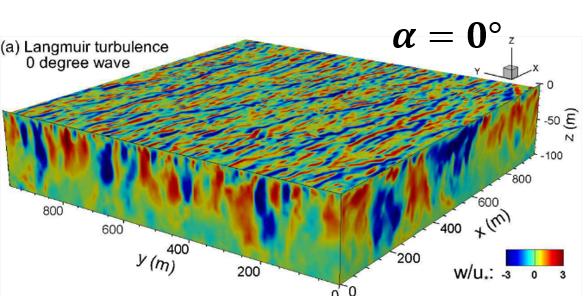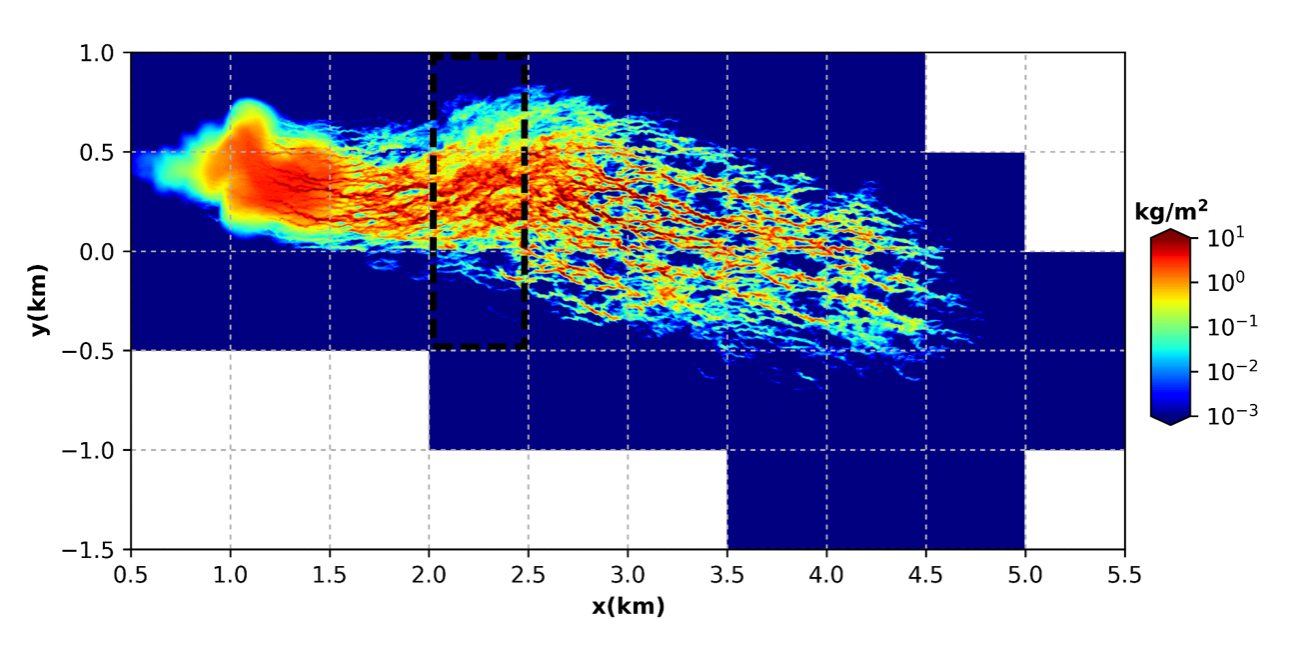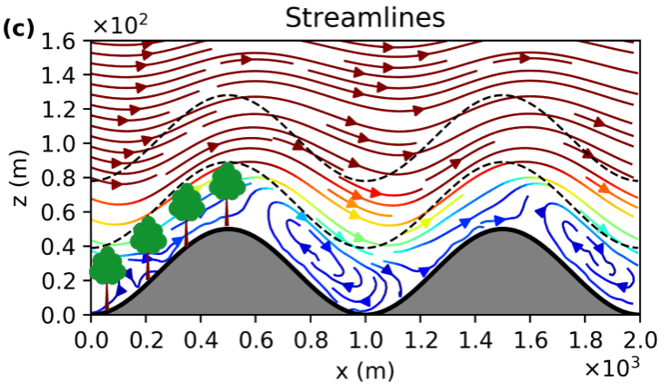陈笔澄博士是91看自拍的新晋固定科研人员。他分别于2010、2013年获得北京大学大气与海洋科学系学士、硕士学位,于2017年获得美国宾夕法尼亚州立大学气象学博士学位。自2017年9月起,陈笔澄博士先后在美国加州大学洛杉矶分校、加州大学伯克利分校从事博士后研究。2021年12月,陈笔澄博士加入91看自拍并获得南强青年拔尖人才支持计划B类人才称号。

【陈笔澄博士2019年在美国加州海岸】
陈笔澄博士的研究兴趣集中于海洋与大气边界层流体动力学及其内部的物质输运与扩散问题。其细分领域包含海洋波浪—洋流相互作用,海洋混合层油污输运与扩散,以及平缓地形下的大气冠层气流动力学等。这些研究领域的共同点在于需要处理复杂界面影响下的边界层通量计算问题。该领域被边界层动力学学科专家、美国国家工程院院士Margaret A. Lemone女士称为当前急需解决的边界层动力学六大挑战之一。
陈笔澄博士研究组主要采用大涡模拟数值模拟技术作为研究工具。大涡模拟是一种能直接解析海洋与大气中大部分三维小尺度运动(如湍流)的先进计算流体力学模拟手段。因此,该手段已成为当下在难以获得观测数据的情况时,探索流体动力学与开发湍流通量参数化的主流手段之一。通过与诸如拉格朗日扩散模式等其他传输模式结合,陈笔澄博士研究组可在各类边界层湍流运动中追踪各类示踪物质(如气体、颗粒物)的运动过程与轨迹,揭示海洋与大气中各类物质的输送与混合过程。

【海洋表层洋流与波浪共同作用形成的规则条带状朗缪尔湍流。该湍流的存在会极大促进海洋表层的物质混合。】
在国外期间,陈笔澄博士致力于研究复杂界面条件下地球流体边界层动力学与物质传输过程。
对于海洋边界层,陈笔澄博士曾参与由墨西哥湾研究协会资助的研究项目“海洋表层油污扩散过程的大涡模拟:次网格参数化的开发、测试与应用”“海洋上层油污团的扩散与演变:多尺度物理扩散机制与油污治理方案的探索”,旨在解决史上最大的溢油事故—墨西哥湾深海溢油的油污污染及治理问题。在这些研究项目中,陈笔澄博士发现了朗缪尔湍流(由波流相互作用产生)对油污的水平输运及垂直混合均有较大影响。这些过程如果在设计油污区域扩散模型时被忽略,将会给油污扩散路径的预报带来较大误差。陈笔澄博士进一步研究了油污分散剂(一种用于降低油滴粒径并促进垂直混合的化合物)使用对油污扩散的影响。结果显示,在洋流条件不变的情况下,分散剂的使用会极大地改变油污团覆盖范围的大小、区域以及传输方向。未来油污治理方案中需要考虑这些效应带来的传输影响。

【次中尺度涡与湍流共同作用下的油污扩散过程。图中油污的覆盖区域由油污的柱浓度表示。注意到油污团同时展现出次中尺度环流的蜿蜒特征与朗缪尔湍流的条带状特征。】
在针对大气边界层的研究中,陈笔澄博士主要参与了由美国国家科学基金委员会资助的科研项目“复杂地形上的植被表面细颗粒物沉降:从树叶尺度到区域尺度的表征”。项目旨在寻找平缓地形条件下,森林塔站通量观测的经典水平均一假设的合理性以及与之相关的误差来源。通过对大涡模拟以及拉格朗日模式模拟结果分析,该研究发现了一条全新的森林冠层内部物质输送通道。该通道由地形引起的平均流动异变和湍流运动共同作用产生。由于这条通道的存在,平缓地形上的森林冠层物质扩散会产生很强的“烟囱效应”,导致经典水平均一假设不再成立。该效应会随着离地高度下降而增强,可能对由土壤呼吸作用产生的二氧化碳扩散产生显著影响。但目前该潜在过程还需要未来研究加以验证。

【平缓起伏地形上的植被冠层中的过山气流。注意地形背风面会形成明显的气流回流区,在地表附近可将山底物质输送至山顶。】
以上结果已发表在Ocean Modelling, Journal of Geophysical Research: Oceans,Physical Review Fluids,Quarterly Journal of the Royal Meteorological Society和Journal of Geophysical Research: Atmospheres上。
陈笔澄博士研究的特色在于最大程度地应用数值模拟技术研究小尺度湍流运动与混合过程。由于大涡模拟具备直接解析大部分湍流运动的能力以及复杂界面边界层观测数据获取的困难性,相比于传统分析实验观测数据,陈博士的研究通常直接运用数值模拟数据观察复杂流动结构和对通量进行直接计算。同时,高分辨率数值模拟需要运用诸如Python, Fortran和Julia等高性能编程语言。
在接下来的工作中,陈笔澄博士将专注于近海海表边界层与海底边界层的耦合效应。海洋表底边界层耦合下的湍流运动控制着近海物质的混合及其与毗邻区域的交换,但目前仍未受到广泛关注。此类研究将有助于揭开近海海域的海气相互作用、跨密度面输送以及沉积物再悬浮等过程的奥秘。
陈笔澄博士目前正在组建自己的科研团队。欢迎任何对海洋与大气边界层动力学及基于高性能编程语言(例如Python,Fortran和Julia)的数值模拟技术感兴趣的同学随时联系,工作邮箱:bchen@xmu.edu.cn,个人主页:https://mel2.xmu.edu.cn/faculty/bichengchen/。
Dr. Bicheng Chen: An Explorer of Fluid Dynamics in Oceanic and Atmospheric Boundary Layers
Dr. Bicheng Chen is an associate professor of physical oceanography at the State Key Laboratory of Marine Environmental Science. He received his B.S. and M.S degrees from the Department of Atmospheric and Oceanic Sciences at Peking University in 2010 and 2013. In 2017, he received his Ph.D. from the Department of Meteorology, Pennsylvania State University. From September 2017, Dr. Chen was engaged in postdoctoral projects at the University of California, Los Angeles, and University of California, Berkeley. In December 2021, he joined Xiamen University and is currently funded by the Nanqiang Young Talents Supporting Program (type B).
Dr. Chen's research interests focus on fluid dynamics in oceanic and atmospheric boundary layers and substance transport and dispersion within these regions. His specific research topics include wave-current interactions in the ocean, oil dispersion and mixing in the ocean mixed layer, and atmospheric canopy flow over rolling topographies. These specific topics deal with fluxes in the presence of complex interfaces, which has been determined to be one of the six most challenging issues in boundary layer meteorology by Dr. Margaret A. Lemone, a member of the National Academy of Engineering (USA).
The primary research tool used in Dr. Chen's group is the Large-eddy simulation (LES). LES is an advanced computational fluid dynamics technique that is able to resolve most three-dimensional small-scale motions, such as turbulence, in the ocean and atmosphere. As such, it has become one of the most popular tools for exploring fluid dynamics and flux parameterizations in conditions where field observations are not feasible. Combined with a technique such as the Lagrangian tracking model (LTD), Dr. Chen's group can track various types of tracers' (e.g., gases, particles) motions and trajectories within different types of turbulent flows, revealing the transport and mixing process for certain substances within the ocean or atmosphere.
While abroad, Dr. Chen has been involved in research projects grouped into two major branches, depending on the specific fluid types (ocean or atmosphere).
For the oceanic part, he joined two projects funded by the Gulf of Mexico Research Initiative (GoMRI). These projects aim to investigate the impacts of oil, dispersed oil, and dispersants on the ecosystems of the Gulf of Mexico following the Deepwater Horizon oil spill (the world's largest oil spill event). In these projects, Dr. Chen has found significant modulations in horizontal transport and vertical oil mixing by Langmuir turbulence, a specific type of turbulence generated by wave-current interaction. Current regional models have not captured these effects, causing large transport errors. Moreover, Dr. Chen further estimated the potential implications of applying oil dispersants, chemical compounds used to reduce droplet sizes and enhance vertical mixing. The results show that oil dispersants can significantly change the oil horizontal dilution rate, trapping zone, and transport routes despite unchanged flow conditions. These transport effects need to be considered in future oil spill remediation efforts.
For the atmospheric part, he joined one project funded by the National Science Foundation (USA). The goal is to seek primary error sources in forest tower measurements by testing the validity of the horizontal homogeneity assumption employed in field campaigns over gentle rolling topographies. Based on the solutions from the LES and Lagrangian tracking models, Dr. Chen identified a new unique in-canopy pathway over rolling topography for tracer escape, formed by the co-action of mean advection and turbulent transport. Due to this pathway, a strong “chimney effect” for substance transport is formed above the canopy, leading to the breakdown of the horizontal homogeneity condition even in the presence of a very gentle topography. Notably, this effect gets intensified as it gets close to the surface which might have a considerable impact on the transport of CO2 emitted from soil respiration; however, future studies are needed to investigate this potential process.
The results of the above research projects have been published in Ocean Modelling, Journal of Geophysical Research: Oceans, Physical Review Fluids, Quarterly Journal of the Royal Meteorological Society and Journal of Geophysical Research: Atmospheres.
The characteristics of Dr. Chen's work are to investigate small-scale turbulent motions and mixing using numerical modeling techniques. Because of the direct turbulence-resolving feature of LES and the infeasibility of field observation in boundary layers with complex interfaces, Dr. Chen's research usually observes complex flow structures with numerous details and involves direct flux calculations in the entire three-dimensional space using only numerical data instead of traditional field data. His research needs to be conducted with high-performance programming languages such as Python, Fortran, and Julia.
His next project will investigate the coupling between the oceanic surface boundary layer (SBL) and bottom boundary layer (BBL) in shallow-water coastal regions. The turbulent flow associated with this coupling controls substance mixing and exchanges within these regions, but previous studies rarely investigated this process. The investigations of SBL-BBL coupling will help understand important processes such as air-sea exchanges, diapycnal transport, and sediment re-suspension in the coastal ocean.
Dr. Chen is building his research group at MEL. If any students are interested in his research areas about oceanic and atmospheric boundary layers or numerical techniques specializing in programming languages such as Python, Fortran, and Julia, please feel free to contact him at bchen@xmu.edu.cn. For more information please visit: https://mel2.xmu.edu.cn/faculty/bichengchen/.